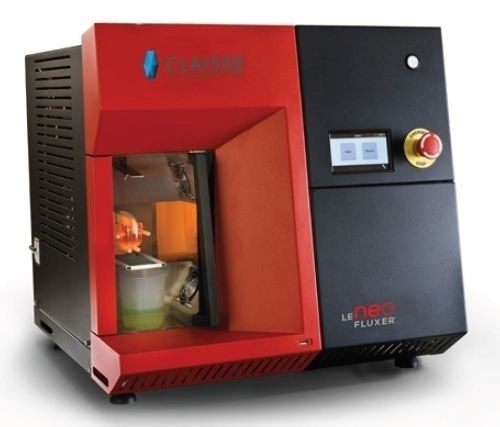Fuel oil, a key by-product obtained from petroleum refining, is mainly utilized as fuel for cargo ships engines and ocean liners as well as in industrial plants and power plants.

Image Credits: shutterstock.com/ESB Professional
Petroleum refineries often use fluid catalytic cracking (FCC) process to optimize the distillation of high octane hydrocarbons[1]. The FCC process often involves some contaminants such as calcium, sodium, silicon, vanadium, iron, and nickel, which may be transferred into the fuel oil during the process.
It is crucial to know the contaminant concentration, as these elements become adhesive at certain temperatures, and can corrode reheater tube surfaces, combustion chambers, and other components in boilers and engines[2]. It is necessary to avoid corrosion at any cost as it leads to wear, thus leading to additional maintenance and replacement expenses.
This article demonstrates the use of borate fusion as a dissolution technique for inductively coupled plasma emission spectroscopy (ICP-OES) analysis to meet the accuracy, precision, and recovery prerequisites in standard methods such as ASTM D 5184[3], IP 377[4] and IP 501[5].
The LeNeo® fusion instrument (Figure 1) will facilitate this preparation step.
As outlined in the standards, a lithium metaborate with 1.5% lithium bromide integrated (LiM/1.5% LiBr) flux is employed in place of the lithium tetraborate blended with 10% lithium fluoride (LiT/LiF 90/10) flux to eliminate the loss of silicon caused by the reaction with fluoride, thereby increasing the solubility of the analytes present in the fuel oil.

Figure 1. The LeNeo® fusion instrument
Method
Apparatus and Instrument Conditions
Borate-based solutions were created using an automatic Claisse® LeNeo fusion instrument, which provides homogeneous heating through its preset fusion programs, superior insulation properties, and resistance-based electrical system. These features allow repeatable and reproducible fusion conditions to be achieved, in addition to a perfect retention of volatile elements.
The samples were ignited using a Fisher Scientific™ Isotemp™ muffle furnace. The data was collected using a PerkinElmer® Optima® 7300 DV ICP-OES spectrometer. Table 1 lists out the operating parameters used on the spectrometer.
Table 1. Optima 7300 DV operating parameters
| Nebulizer |
GemTipTM Cross-Flow |
| Spray chamber |
Scott |
| Injector |
Alumina 2 mm |
| RF |
1500 W |
| Argon flow |
Plasma: 16 L/min
Nebulizer: 0.8 L/min
Auxiliary: 0.4 L/min |
Sample flow rate
|
1.0 mL/min
|
Global Sample Preparation Method
The following steps were involved in each sample preparation before being introduced into the fusion process:
- Weigh the sample in a Pt/Au crucible
- Burn the combustible material with an open flame
- Ignite the carbon residue in a muffle furnace at 550°C overnight
After mixing the sample with 0.4g of LiM/1.5% LiBr flux in a Pt/Au crucible, it was fused using a fully automatic LeNeo instrument.
The melt was then automatically poured into 80mL of a 10% hydrochloric acid (HCl) solution, followed by magnetic agitation in order to produce a complete dissolution.
The LeNeo instrument took below 15 minutes to complete the entire fusion and dissolution process. The ensuing solutions were then made up to 100 mL in 10% HCl for further analyses on the PerkinElmer Optima 7300 DV ICP-OES.
Results
The high content of lithium in this matrix causes a suppression or boost in signals for some elements - this effect can be observed with many easily ionizable elements. This effect was counteracted by using matrix matching and internal standards. Sample dilution eliminated any clogging due to the high salt content of the matrix.
The LiM/1.5% LiBr matrix was used to prepare the calibration solutions of all elements, as described for the samples.
Calibration curves were generated using a concentration range close to the sample contentrations - all sample concentrations were within the range of the calibration. For each element, five points including the calibration blank were employed. Each curve had a correlation of over 0.999.
Method Detection Limits
Method detection limits (MDLs) were based on 10 repeated measurements on a set of diluted sample solutions. The standard deviation of the 10 duplicate measurements (S10) was multiplied by 3 to obtain the MDL (Table 2).
MDL = 3 x S10
Method Concentration Range
The ICP-OES analysis method was validated for analyte determination within the concentration ranges listed in Table 2.
Table 2. Analytes of interest with selected wavelength, viewing mode, concentration range and method detection limit (MDL)
| Elements |
Wavelengh (nm) |
View |
Concentration range (mg/kg) |
MDL(mg/kg) |
| Minimum |
Maximum |
| Al |
396.153 |
Axial |
5 |
150 |
0.01 |
| Ca |
396.847 |
Radial |
3 |
100 |
0.3 |
| Fe |
259.939 |
Radial |
2 |
100 |
0.03 |
| Na |
589.592 |
Radial |
1 |
100 |
0.3 |
| Ni |
227.022 |
Axial |
1 |
100 |
0.02 |
| P |
177.434 |
Axial |
1 |
60 |
0.2 |
| Si |
251.611 |
Radial |
10 |
250 |
0.2 |
| V |
270.093 |
Axial |
1 |
400 |
0.04 |
| Zn |
202.548 |
Axial |
1 |
70 |
0.02 |
Accuracy
Table 3 demonstrates the accuracy of the 10 duplicate measurements of four fuel oil samples.
These samples come from the round robin titled, “Committee D2 Proficiency Testing Program #6 Fuel Oil”. The mean values of each set of samples in the round robin were used to calculate the true values, and the accuracy values in Table 3 how close the results were to these true values.
Table 3. Accuracy measurements on 4 fuel oil samples
| Elements |
F61409 (%) |
F61501 (%) |
F61505 (%) |
F61509 (%) |
| Al |
99 |
91 |
89 |
89 |
| Si |
97 |
97 |
98 |
97 |
Recovery
The recovery values acquired in four similar matrixes are shown in Table 4. Recovery was estimated on five duplicates for each spiked sample.
Table 4. Recovery measurements on 4 fuel oil samples
| Elements |
F61409 (%) |
F61501 (%) |
F61505 (%) |
F61509 (%) |
| Al |
107 |
93 |
98 |
101 |
| Ca |
97 |
95 |
100 |
100 |
| Fe |
93 |
93 |
94 |
95 |
| Na |
98 |
93 |
101 |
106 |
| Ni |
95 |
101 |
97 |
101 |
| P |
103 |
97 |
98 |
97 |
| Si |
99 |
99 |
96 |
105 |
| V |
99 |
95 |
106 |
98 |
| Zn |
102 |
104 |
105 |
100 |
Precision
The standard deviation on 10 duplicate samples prepared and analyzed on different days was multiplied by 2.77[6] to obtain the experimental repeatability (SD10). Within the concentration range, the experimental repeatability should not go beyond the expected repeatability (SDstd) that was estimated as outlined by the standards[3,4,5] (Table 5).
Table 5. Repeatability measurements on 1 fuel oil sample
| Elements |
1
mg/kg |
2
mg/kg |
3
mg/kg |
4
mg/kg |
5
mg/kg |
6
mg/kg |
7
mg/kg |
8
mg/kg |
9
mg/kg |
10
mg/kg |
Average |
SD10
mg/kg |
SDstd
mg/kg |
| Al* |
3.0 |
3.2 |
3.3 |
3.2 |
3.6 |
3.4 |
3.0 |
3.0 |
3.3 |
3.5 |
3.2 |
0.6 |
0.2 |
| Ca |
9.6 |
10.1 |
9.7 |
9.7 |
10.3 |
9.7 |
10.1 |
10.2 |
10.4 |
9.6 |
9.9 |
0.8 |
1.7 |
| Fe |
27 |
29 |
28 |
28 |
28 |
27 |
28 |
27 |
28 |
28 |
28 |
2 |
4 |
| Na |
19 |
20 |
19 |
19 |
19 |
19 |
18 |
18 |
20 |
19 |
19 |
2 |
3 |
| Ni |
50 |
53 |
51 |
51 |
54 |
51 |
51 |
50 |
51 |
51 |
51 |
3 |
7 |
| P |
3.9 |
3.9 |
3.7 |
4.0 |
3.7 |
3.9 |
3.5 |
3.7 |
3.7 |
3.8 |
3.8 |
0.4 |
1.2 |
| Si* |
6.4 |
6.2 |
6.4 |
6.0 |
6.2 |
6.3 |
6.3 |
6.3 |
6.1 |
6.6 |
6.3 |
0.4 |
0.4 |
| V |
219 |
226 |
218 |
221 |
218 |
215 |
221 |
219 |
218 |
217 |
219 |
8 |
17 |
| Zn |
4.6 |
4.7 |
4.8 |
4.7 |
4.7 |
4.7 |
4.5 |
4.7 |
4.6 |
4.7 |
4.7 |
0.2 |
1.0 |
*Values outside the concentration range
Conclusion
The aforementioned results have demonstrated the suitability of the sample preparation process by fusion with a LiM/1.5% LiBr flux for the ICP-OES analysis of fuel oils.
The use of the LeNeo instrument for sample preparation is advantageous in many ways for all laboratories. It is simple, as it enables complete dissolution without acid heating. It is also fast, as it completes a fusion cycle within 15 minutes that includes the dissolution time.
With more than 89% accuracy and 93% to 107% recovery, the method shows its high reliability and validity. The good repeatability values obtained demonstrate the ability of the LeNeo instrument to provide a reproducible sample preparation, thereby meeting the reproducibility and repeatability as outlined by the standards ASTM D 5184, IP 377 and IP 501.
References
-
"Octane-Enhancing Zeolitic FCC Catalysts: Scientific and Technical Aspects", J. Scherzer, Catal Rev, 1989. DOI: 10.1080/01614948909349934
-
ISO 8217:2010 - Specifications of Marine Fuels, 4th Ed., International Organization for Standardization, 2010.
-
ASTM D5184-12 - Standard Test Methods for Determination of Aluminum and Silicon in Fuel Oils by Ashing, Fusion, Inductively Coupled Plasma Atomic Emission Spectroscopy, and Atomic Absorption Spectroscopy, ASTM International, 2012.
-
IP 377 - Determination of Aluminium and Silicon in Fuel Oils - Inductively Coupled Plasma Emission and Atomic Absorption Spectroscopy Methods, International Organization for Standardization, 2014.
-
IP 501 - Determination of Aluminium, Silicon, Vanadium, Nickel, Iron, sodium, Calcium, Zinc and Phosphorous in Residual Fuel Oil by Ashing, Fusion and Inductively Coupled Plasma Emission Spectrometry, International Organization for Standardization, 2005.
-
ASTM E117-08 - Standard Practice for Use of the Terms Precision and Bias in ASTM Test Methods. ASTM International, 2008.
Click here for more information about the LeNeo from Claisse

This information has been sourced, reviewed and adapted from materials provided by Claisse.
For more information on this source, please visit Claisse.